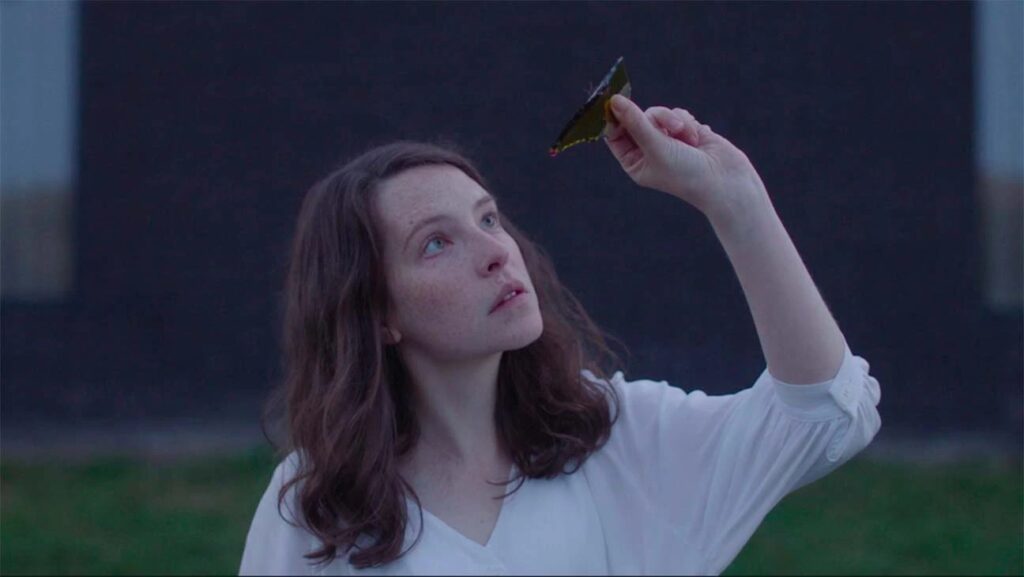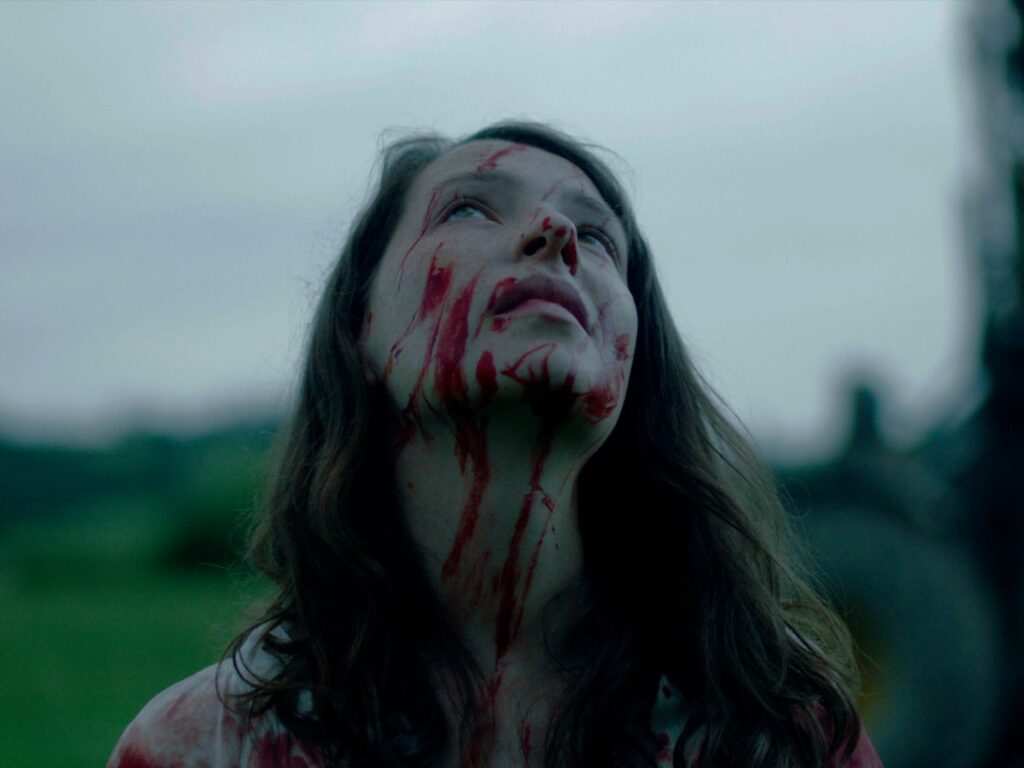During the Q&A with director Lee Haven Jones that followed the BFI preview of The Feast, the handsome Welshman who had sat next to me began to effervesce with praise at the political underpinnings of the film’s linguistic Welsh-ness. He spent ten minutes before the film speaking in Welsh to his friend with such fervour that one couldn’t help but feel a little thrill of anticipation for what was to come. I let myself be carried off to the lilt and flow of Welsh fricatives until the film began.
When I’m reviewing a film, I often – with brightness as low as it’ll go and night-mode display – use my phone to make notes. I don’t have long nails and I type silently; I’d even worn a billowy dress specifically so that I could use it as a light shield and not disturb anyone around me. Five minutes in, however, I felt anger emanating from the seat next to me. “Can you stop texting?” the lovely Welshman hissed. A little dumbstruck and rather admonished I whispered back, “I’m not texting, I’m making notes!”. I felt his glare defiantly reach back through the darkness. Shrinking into the West coast of my seat, I gathered my skirt around the screen in shame. Perhaps this rebuke tinged my viewing experience of this folk-inflected eco-horror or maybe it was simply the case that, much like the Welshman’s gentle lilt, this was a feast for the senses that fell short of real delectability.

For those of us whose mother tongue is English and only English, it might be difficult to relate to my partner-in-aisle’s dogged enthusiasm (heavy breathing, little unvoiced seat squirms and gleeful, sharp exhales) for The Feast’s linguistic significance. For most young English people, nationalism is always a little embarrassing, but that probably (read: definitely) has to do with our chequered history internationally. Although I didn’t share in the Welshman’s investment in the language aspect of the film, I did appreciate it; although, as Jones said himself, it really just feels like watching any other contemporary European film with subtitles.
The film’s opening sequence, taking place in a dewy, bucolic pasture, perfectly encompasses much of what’s to come: this feast is not only gustatory, but visually and sonically titillating. The first thing to strike the viewer is a deafening rumble from what looks to be a hydraulic drill, burrowing into the otherwise untouched landscape. Sound recordist Dominic Corbisiero deserves a special mention here – the interplay of diegetic and non-diegetic sound throughout is incredibly crafty. With audio sensitivity boosted, the roar of machinery is isolated and soars to a tremendous din, eventually petering into a tinnitus-like ring that one might associate with film scenes of bombarded, war-torn battlefields.
This taste for sound continues as the film unfolds, but The Feast’s plot remains sparse. So sparse, in fact, it can be surmised in a single line: a hired catering assistant helps an overbearing wife/mother, Glenda (Nia Roberts), to arrange and prepare for a dinner party; carnage ensues… eventually. This is a film that takes its time. Unfortunately, rather than provoking the intended ravenous appetite in viewers, the lengthy buildup to any real horror or action is likely to induce a hangry delirium.

The first twenty minutes of The Feast are strong; we are synesthetically tickled and basted in the luxuriant drippings of Bjørn Ståle Bratberg’s impressive cinematography. After the first field scene, we travel to a large contemporary home nestled in the Welsh hills. Accompanied by an orchestral soundtrack, we float through the various corridors and rooms of this open-plan, modern dwelling. This isn’t a unique setting for horror films of late – it evokes the same sort of tone (and latent unease surrounding wealth) that Bong Joon-ho’s Parasite does, but with considerably less gusto, humour or charm.
As the next scenes unfold, we continue to hear the most cursory of noises: food being prepared on chopping boards, cutlery clinking, and water running. It’s almost as if we take on the role of the landscape itself, listening to the violent disruption interposed by the humans who play upon it. This vague environmentalism, it turns out, is the principal concept around which the film pivots. Glenda and husband Gwyn (Julian Lewis Jones) have sold off ancestral land to dinner party guest Euros (Rhodri Meilir), a greedy developer whose avarice extends from land acquisition to gourmet fare. Their other guest, local farmer Mair (Lisa Palfrey), has been invited in hopes she’ll also be enticed to sell her property to Euros. Primped parvenu Glenda hopes that her overbearing dinner spread and expensive wall art will pressure Mair to sell, with the whole family assembled to aid in the fleecing.
Glenda and Gwyn’s sons – drug-addicted, self-pronounced urbanite Guto (Steffan Cennydd) and leery sportsman Gweirydd (Sion Alun Davies) – are also present. Although we soon learn of their fraternal feuding, the pair are almost reminiscent of golfing-attired goons Peter and Paul from Michael Haneke’s Funny Games. Each son attempts to strike up a conversation with the timid hired hand, Cadi (Annes Elwy), whose puzzlingly bedraggled appearance and pallor seem to cast a waif-like, elfin spell over the two youths. At first, Cadi seems withdrawn and jumpy, shrinking at the sight and sound of Gwyn’s rifle (he’s out hunting rabbits for dinner). As the film progresses, however, Cadi’s quietude becomes icy assurance as she witnesses, unfazed, the unfolding mayhem.

What she lacks in dialogue, Cadi makes up for in a watchful, scopophilic gaze with which the viewer is aligned early on. Particularly noteworthy The Feast’s repeated use of a voyeuristic frame: the first instance of which consists of a wide-angled glimpse of Gweirydd shaving his balls in the bath. A single drop of blood cascades into the water and we wait for it to make contact with the surface. This suspended tension is the central force that propels the audience through the affair.
The film’s attention to these minute bursts of violence (a hack-job of a shave, the skinning of rabbits, distant gunshots, intense focus on bodily fluids) almost makes up for the absence of character development or plot. The Feast only establishes the folkloric premise for its supernatural twist during its climax, and its environmentalist slant is neither subtle nor outspoken enough to be truly impactful.
The film’s conclusion is a hallucinatory eruption of its disparate elements, as nature is brought to bear on those who dared disturb her. But Bratberg’s cinematography remains too gorgeous and prosaic to muster sufficient repulsion to The Feast’s attempt at horror gore. It’s during the final half-hour that the pacing really runs away with itself. No clear rationale presents itself to offer narrative catharsis, and I was left only with frustration and hunger.
After the film, regarding a question from an audience member on the importance of filming in Welsh, Jones stated that “It wasn’t a decision. We all speak Welsh; It’s our mode of everyday expression. It’s about who we are, rather than being a statement.” This is the challenge the film faces – how to tackle the subject of its own Welshness whilst also entertaining an international audience. As the director speaks, it often seems like reception was at the heart of the production. What Jones likes about theatre is that the audience is involved in the relationship between the director and the creation of meaning; television, he claims several times, is candyfloss, or a “soup of naturalism”. In that spirit, perhaps The Feast is like popcorn… Moreish, but lacking the substance to satiate.
The Feast is out now.
